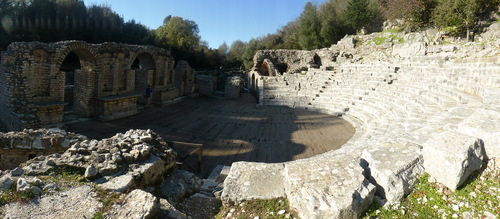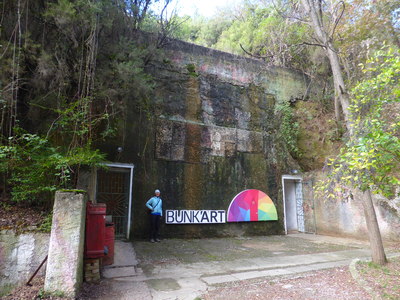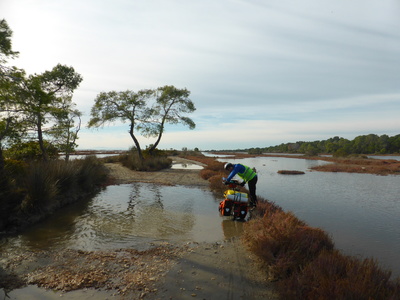In the Land of Thieves and Mobsters?
Posted on 2018-12-18
Albania has a terrible international reputation. When we told people that we were going to Albania, the first associations many people made were along the lines of "thieves", "mobsters" and "Europe's Afghanistan". We met people planning to go to Albania who were themselves worried about being robbed there, and it seemed to be one of the countries that caused the most concern among our friends and relatives when we explained our planned route. From those who had been there, however, we only heard good stories, and that's the only kind we can tell here, too.
Everywhere we cycled, especially off the main roads, people greeted us, honking their car horns and giving us a thumbs up, or waving from the roadside. Sometimes people gave us some of their plentiful oranges, and when we seemed lost, someone would quickly ask if he could help. So we felt safe all the time, even when wild camping in not entirely hidden places. Traffic was also better than expected. It's chaotic, but the roads were not too busy and cars moved relatively slowly.
Our wild camp at a small lake near Thumanë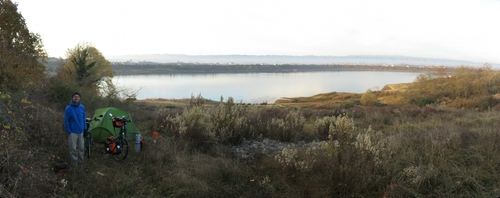
The first half of our stay in the country, we followed relatively level roads and often had some nice tailwind, so we travelled quite fast. Our first stop was in Shkodra, where we stayed with an American couple that seems to host almost every bicycle tourist passing through the area. Even in November, they had at least one cyclist at their place every day. This surprised us, as we had met almost no other bicycle tourists on on our route, and we wonder what routes these other cyclists are taking!
Hannah with our hosts in Shkodra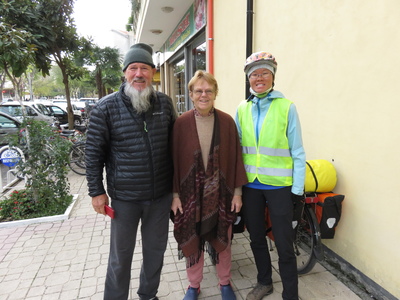
From Shkodra, we continued on to the capital, Tirana. There we visited Bunk'Art, a history and art museum housed in a massive Cold War anti-nuclear bunker built by the communist government. Interspersed with pieces of contemporary art, the museum documents the modern history of Albania, beginning with World War II and ending with the overthrow of communism. A significant part of the exhibition describes the time under the communist rule of dictator Enver Hoxha, who, after coming into power, first cut ties with the Western world, then the neighbouring countries of Yugoslavia, then, after the death of Stalin, with the Soviet Union, and finally, also with China, leaving Albania without any friends and making it one of the most isolated countries in the world. With a paranoid fear of being attacked, Hoxha also embarked on a massive programme of bunkerisation, building 173,371 bunkers across the country, or about 1 per 11 citizens. These bunkers were never used for their intended purpose and only diverted resources from other forms of development.
Since the fall of communism in Albania in 1992, the country has been slowly developing, but many facets of everyday life that we see every day remind us of other developing countries we have visited. The super friendly people, the people walking everywhere around and between the towns and villages, the vehicles that get a second lease of life here (mostly Mercedes Benz cars, and other German brands), the small businesses everywhere, the herds of animals crossing the roads... it definitely felt different from all the previous countries we had been through.
A herd of goats suddenly came down the road from the border crossing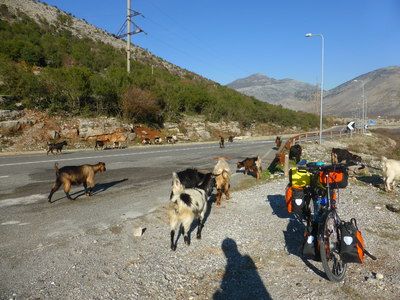
From Tirana, we visited the old city of Durrës on the coast, and then continued our way south. We decided to wild camp one night in the Divjakë-Karavasta National Park. All was going well, until the next morning when we decided to take a road across the Karavasta lagoon, one of the largest in the Mediterranean. We had seen some cars driving on the road, and it didn't look too bad from afar. The lagoon also looked really pretty, and the road literally goes in the middle of the lagoon, with water on both sides, so we thought it would be worth the ride. Once we got on the road, however, the road only got from bad to worse, with massive potholes filled with water, sometimes connecting both sides of the lagoon. It took us forever to cross the 6km or so across the lagoon...
Leaving the lagoon, both us and our bicycles were soaked with muddy water and desperately needed a wash. We stopped at the first "lavazh" (car wash) place we saw and got our bicycles thoroughly sprayed down. After cleaning and drying ourselves too, we headed into the hills of southern Albania, following a valley to the UNESCO World Heritage town of Gjirokastër.
Gjirokastër is famous for its well-preserved Ottoman Old Town of big stone houses. The whole city is overlooked by a huge, impressive fortress that we explored in detail. This was also the second time (after Tirana) that we visited a traditional restaurant and tried Albanian dishes such as rice balls, baked cheese with honey and sesame, bean soup and tomato koftas.
View of Gjirokastër from the castle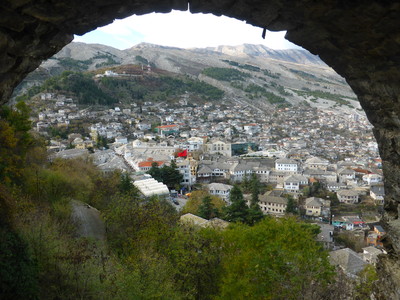
We then left the valley and crossed over some mountains back down to the coast. The mountain slopes on the sea-facing side had much more vegetation than the previous valley, and on the way down we came across the "Blue Eye", a very beautiful place where water from an underground river comes up to the surface.
The "Blue Eye", where water from an underground river reaches the surface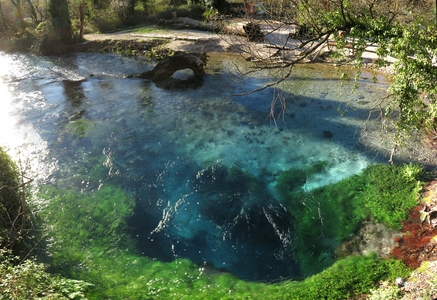
Our destination on the coast was the ancient city of Butrint. We spent a few hours walking among the ruins of Greek, Roman and medieval origins. The archaeological site was described as being one of Albania's most important tourist attractions and usually crowded, but when we were there, we didn't see any other tourists at all!
Ancient theatre of Butrint from the 3rd century BC